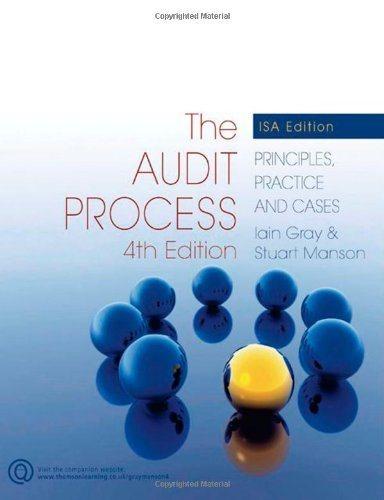Question
Q.1 ) Read the case below and answer the questions given at the end: ABC shirt company currently produces regular shirts. The set of operations
Q.1 ) Read the case below and answer the questions given at the end:
ABC shirt company currently produces regular shirts. The set of operations carried out in the manufacturing of shirts is given in Table 1. Shirt patterns are cut on a computer-controlled cutting machine which currently cuts 60 layers of cloth (of the same or multiple colors) at the same time. Setting up the machine is a laborious process---(it takes 1.5 minutes to carefully roll out each layer of fabric on the cutting table. Patterns for 8 shirts are laid out parallelly at the same time on the cutting machine. Thus, for each shirt pattern laid out, pieces for 60 shirts would be cut simultaneously. Once the fabric is laid out, it takes 30 minutes to cut all pieces for 8 patterns of 60 layers. 4 cutting machine operators were fully utilized for this operation.
After cutting, batches of size 60 are made. These batches are then sent to sewing wherein 24 workers carry out different sewing operations. The movement of work in process items is carried out by 4 material handlers. A total of 40 direct workers (performing all the operations from cutting to packing) are present in the system. All the workers do work for an 8-hour shift, 5 days a week, 20 days per month. The workers are paid Rs. 400 per hour on regular shifts and Rs. 600 per hour on overtime. Table 2 gives the other cost structure and Table 3 gives the activity time for different operations. Currently, the monthly demand for ABC shirts is 16000 shirts.
Table 1: operations and WIP (existing system)
| Type of operation | Number of workers | Number of Machines | Average WIP (number of 60-shirt batches) |
| Cutting | 4 | 1 | 16 |
| Sewing | 24 | 24 | 144 |
| Inspection | 4 |
| 12 |
| Ironing | 4 | 4 | 12 |
| Packaging | 4 |
| 12 |
Table 2: Cost structure (existing system)
| Raw materials | Rs. 350 |
| Total labor (direct +indirect (including material handling and supervisory labor)) | Rs. 225 |
| Other indirect costs (excluding inventory carrying cost) | Rs. 225 |
| Wholesale price | Rs. 1250 |
| Retail price | Rs. 2500 |
Table 3: labor content (existing system)
| Operation | Labor content (minutes/shirt) | Number of workers |
| Sewing_part1 | 3.90 | 8 |
| Sewing_part 2 | 2 | 4 |
| Sewing_part 3 | 3 | 8 |
| Sewing_part 4 | 1.5 | 4 |
| Inspection | 1.8 | 4 |
| Iron | 1.7 | 4 |
| Packaging | 1.75 | 4 |
The organization now wants to introduce custom stitched shirts. The company has an estimated demand of 1000 custom shirts per month. As custom-made shirts have higher margins, ABC wants to go to produce custom shirts. Even with the introduction of custom shirts, the demand for regular shirts remains the same as that of the existing scenario. A new production line is also made for the custom shirt. In this regard, the company has purchased a cutting machine, and to operate that machine, a new worker is hired. The operations to be carried out on custom-made shirt post cutting are the same as that of regular shirts (with the same activity time). For each operation post cutting, a worker from each operation of the existing system is taken. In the new line for the custom shirt, there will be 3 shirts as WIP for each worker for post-cutting operation. The WIP for regular shirts in the new system is given in Table 4. For the custom shirts line, it takes 7.5 minutes to cut 10 layers with a single pattern. In this new context, regular shirt production will happen in the regular shirt manufacturing environment (modified existing system) which is having one worker less in each operation post cutting than the existing system. If the regular time is not enough, overtime can be used to meet the demand as ABCs policy is to meet all the demand. Overtime is available only on whole hour basis (i.e., 1,2,3.hours).
Table 4: New regular shirt system
| Type of operation | Number of workers | Number of Machines | Average WIP (number of 60-shirt batches) |
| Cutting | 4 | 1 | 16 |
| Sewing | 20 | 20 | 108 |
| Inspection | 3 |
| 9 |
| Ironing | 3 | 3 | 9 |
| Packaging | 3 |
| 9 |
Evaluate the ABC shirt company and address the following questions:
- What is the flow rate for regular and custom shirts? (5)
- What is the manufacturing lead time for regular and custom shirts? (4)
- What is the direct labor cost per shirt for regular and custom shirts? (5)
Step by Step Solution
There are 3 Steps involved in it
Step: 1

Get Instant Access to Expert-Tailored Solutions
See step-by-step solutions with expert insights and AI powered tools for academic success
Step: 2

Step: 3

Ace Your Homework with AI
Get the answers you need in no time with our AI-driven, step-by-step assistance
Get Started


